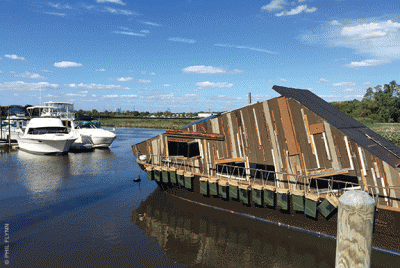
“The project definitely registers in different ways with different people,” says Bethany Wiggin, founding director of the Penn Program for Environmental Humanities. “For many, it’s an inspiration, but some people can find it pretty apocalyptic, too.”
Part learning laboratory, part experiment in sustainable living, WetLand—a collaboration between PPEH, Bartram’s Garden, and creator Mary Mattingly—spent about a month of the fall semester floating on the Schuylkill River. Powered by solar panels, the waterborne habitat engaged curious onlookers with offerings that ranged from public health education to poetry readings to a workshop on “how to make your own seed bomb”—a ball of clay, compost, and flower seeds. Crew members spent nights aboard, and welcomed visitors by day to explore the houseboat’s beehive, rain-collection system, edible garden, and a Franklin Institute exhibit of miniature houses that illuminated ways to improve temperature management and water conservation at home. Other sources of fascination included a solar shower and composting toilet capable of producing usable fertilizer in 90 days.
After a stint moored beneath the Walnut Street Bridge, WetLand floated downriver to Bartram’s Garden. There it hosted fellows from PPEH, students from Columbia and Yale, and Penn undergraduates taking Wiggins’ History and Sociology of Science seminar in “Sustainability and Utopia,” who were tasked with proposing additions to the project, which is expected to resume in the spring. One idea: incorporating a floating water garden filled with water-filtering native plants, which would make WetLand a water remediation project—in addition to the experiment in public art and science education that enlivened Philadelphia’s waterfront this fall. —Sara Schuster C’17

